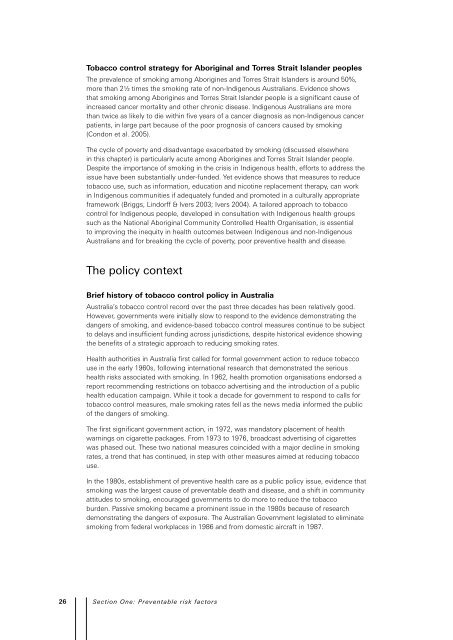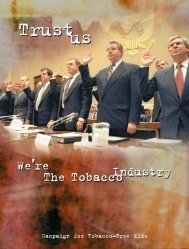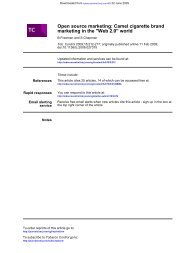National Cancer Prevention Policy - Tobacco Control Supersite
National Cancer Prevention Policy - Tobacco Control Supersite
National Cancer Prevention Policy - Tobacco Control Supersite
You also want an ePaper? Increase the reach of your titles
YUMPU automatically turns print PDFs into web optimized ePapers that Google loves.
<strong>Tobacco</strong> control strategy for Aboriginal and Torres Strait Islander peoples<br />
The prevalence of smoking among Aborigines and Torres Strait Islanders is around 50%,<br />
more than 2½ times the smoking rate of non-Indigenous Australians. Evidence shows<br />
that smoking among Aborigines and Torres Strait Islander people is a significant cause of<br />
increased cancer mortality and other chronic disease. Indigenous Australians are more<br />
than twice as likely to die within five years of a cancer diagnosis as non-Indigenous cancer<br />
patients, in large part because of the poor prognosis of cancers caused by smoking<br />
(Condon et al. 2005).<br />
The cycle of poverty and disadvantage exacerbated by smoking (discussed elsewhere<br />
in this chapter) is particularly acute among Aborigines and Torres Strait Islander people.<br />
Despite the importance of smoking in the crisis in Indigenous health, efforts to address the<br />
issue have been substantially under-funded. Yet evidence shows that measures to reduce<br />
tobacco use, such as information, education and nicotine replacement therapy, can work<br />
in Indigenous communities if adequately funded and promoted in a culturally appropriate<br />
framework (Briggs, Lindorff & Ivers 2003; Ivers 2004). A tailored approach to tobacco<br />
control for Indigenous people, developed in consultation with Indigenous health groups<br />
such as the <strong>National</strong> Aboriginal Community <strong>Control</strong>led Health Organisation, is essential<br />
to improving the inequity in health outcomes between Indigenous and non-Indigenous<br />
Australians and for breaking the cycle of poverty, poor preventive health and disease.<br />
The policy context<br />
Brief history of tobacco control policy in Australia<br />
Australia’s tobacco control record over the past three decades has been relatively good.<br />
However, governments were initially slow to respond to the evidence demonstrating the<br />
dangers of smoking, and evidence-based tobacco control measures continue to be subject<br />
to delays and insufficient funding across jurisdictions, despite historical evidence showing<br />
the benefits of a strategic approach to reducing smoking rates.<br />
Health authorities in Australia first called for formal government action to reduce tobacco<br />
use in the early 1960s, following international research that demonstrated the serious<br />
health risks associated with smoking. In 1962, health promotion organisations endorsed a<br />
report recommending restrictions on tobacco advertising and the introduction of a public<br />
health education campaign. While it took a decade for government to respond to calls for<br />
tobacco control measures, male smoking rates fell as the news media informed the public<br />
of the dangers of smoking.<br />
The first significant government action, in 1972, was mandatory placement of health<br />
warnings on cigarette packages. From 1973 to 1976, broadcast advertising of cigarettes<br />
was phased out. These two national measures coincided with a major decline in smoking<br />
rates, a trend that has continued, in step with other measures aimed at reducing tobacco<br />
use.<br />
In the 1980s, establishment of preventive health care as a public policy issue, evidence that<br />
smoking was the largest cause of preventable death and disease, and a shift in community<br />
attitudes to smoking, encouraged governments to do more to reduce the tobacco<br />
burden. Passive smoking became a prominent issue in the 1980s because of research<br />
demonstrating the dangers of exposure. The Australian Government legislated to eliminate<br />
smoking from federal workplaces in 1986 and from domestic aircraft in 1987.<br />
2 Section One: Preventable risk factors




